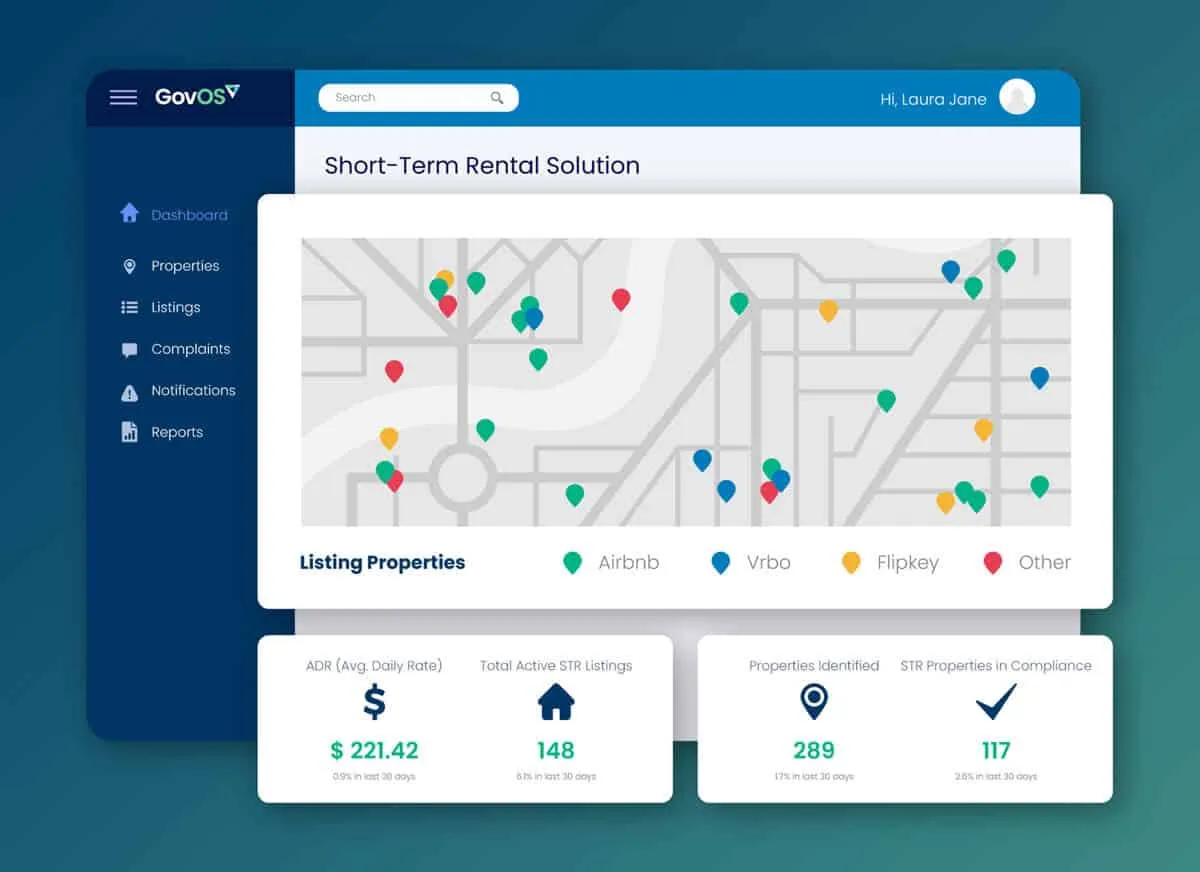Chapter 2
Using Short-Term Rental Compliance Software
Chapter 1
What is a Short-Term
Rental?
Chapter 2
Using Software to Manage Short-Term Rental Compliance
Chapter 3
Chapter 4
Setting Up a Short-Term Rental Registration System
Chapter 5
Chapter 6
Providing Short-Term Rental Resources to Your Community
Chapter 7
Short-Term Rental Policies & Practices Across the U.S.
The growing demand for short-term rentals (STRs) continues to make news, with the industry reportedly poised for further growth in the United States. While short-term rentals have undoubtedly become a popular type of accommodation for travelers, this means local governments are tasked with a new mission: determining how best to manage STRs in a sustainable way that balances the needs of all stakeholders in the community.
With more STR properties to account for, many local governments are setting up programs to help manage the growth. As part of the process, they must decide whether to use short-term rental compliance software to help streamline compliance tasks for staff and citizens. But before we explore the advantages and challenges of using STR software, let’s first review what short-term rental compliance is and why it’s important.
What is short-term rental compliance?
The role of government in managing short-term rentals has evolved over the years. When STRs were still a novel way for property owners to collect extra income by renting out a spare room or second home, many government agencies played a minor role, if any, in monitoring STR compliance. As the industry grew, more state and local governments began exploring ways to ensure STRs comply with established ordinances, policies, and guidelines. This includes requirements around zoning, registration and licensing, health and safety inspections, tax collection, and more.
Short-term rental compliance management has become increasingly important to many local governments because it helps them plan, adapt, and better work together with stakeholders so STRs are more likely to have a positive impact in the community.
Today, some local governments still use manual processes to manage STRs. This means tasks, such as researching and identifying active STRs, processing applications, collecting registration fees or tax, and addressing complaints, are handled manually by staff. Other local governments, meanwhile, use software to help automate and streamline these processes.
Advantages and Challenges of Using Software for Short-Term Rental Compliance
Software solutions for short-term rental compliance offer several benefits to government staff, STR operators, and residents. With the help of technology, jurisdictions can simplify their unique processes around identification, registration, tax collection, and complaint management. Software solutions also provide data insights that help identify trends and contribute to long-term planning.
Let’s take a closer look at some of the ways software can help local governments while also considering potential drawbacks.

Advantages of Using STR Software
- Improves short-term rental compliance rates
- STR software helps agencies identify short-term rentals quickly and efficiently and enables them to more effectively scale to meet the demands of a growing industry. By maintaining accurate, up-to-date compliance data within a single system and deploying digital notification tools to communicate with operators, staff can track and streamline outreach efforts to bring more STRs into compliance.
- Increases revenue from short-term rental taxes and fees
- By automating key processes such as identification, registration, and tax collection, STR software can help departments handle a larger volume of tasks more efficiently and with more accuracy in payment processing. There are fewer human errors and miscalculations—especially for those with higher numbers of STRs to track—leading to more accurate revenue collection.
- Saves time for staff and citizens
- With the help of software, staff can increase internal process efficiencies while also saving time for citizens by allowing them to go online to complete STR-related tasks. In contrast, manual processes, such as filling out paper applications, manually entering data into a system, and collecting paper payments, can become unnecessarily time-consuming for staff and result in longer turnaround times for citizens.
Using Short-Term Rental Compliance Software
Challenges of Using STR Software
- Access to training and support
- For a short-term rental management program to deliver the intended results—such as increased compliance with local regulations—it’s critical to ensure the software provider offers the necessary resources and tools. This includes ongoing training and support services for staff and STR operators in addition to the introductory sessions that cover how to use the system.
- Adopting new technology
- Managing STRs with the help of software means staff and citizens will need to learn how to use the system to complete processes and tasks related to operating a short-term rental. Again, ensuring there is sufficient training and support from the provider is key to helping staff and citizens experience the benefits of using STR compliance software.
- Ensuring data is secure
- When collecting and storing sensitive data, such as short-term rental taxpayer information, it’s essential that the software solution has robust security and data privacy practices in place. If a software provider does not offer advanced security to protect data, then the personal information of STR operators is at risk of being exposed.

Watch a series of demos to see how the GovOS STR solution can work for you!
Which option is better for local governments – software or manually managing STRs?
When considering whether implementing a software solution is the right approach, start by identifying the specific needs and resources of your agency. It’s important to engage in discussions with stakeholders about factors such as scalability, efficiency, data management, and enforcement capabilities.
Compliance software offers many benefits in STR management, including the ability to complete processes faster and with more accuracy. Well-designed software solutions also provide robust security and ongoing support to ensure success with staff and the community.
While automation can certainly make STR tasks more manageable, proper planning and implementation are essential to success. Finding software that can adapt to fit your jurisdiction’s unique needs will help you better support staff and improve STR compliance in the long run.
